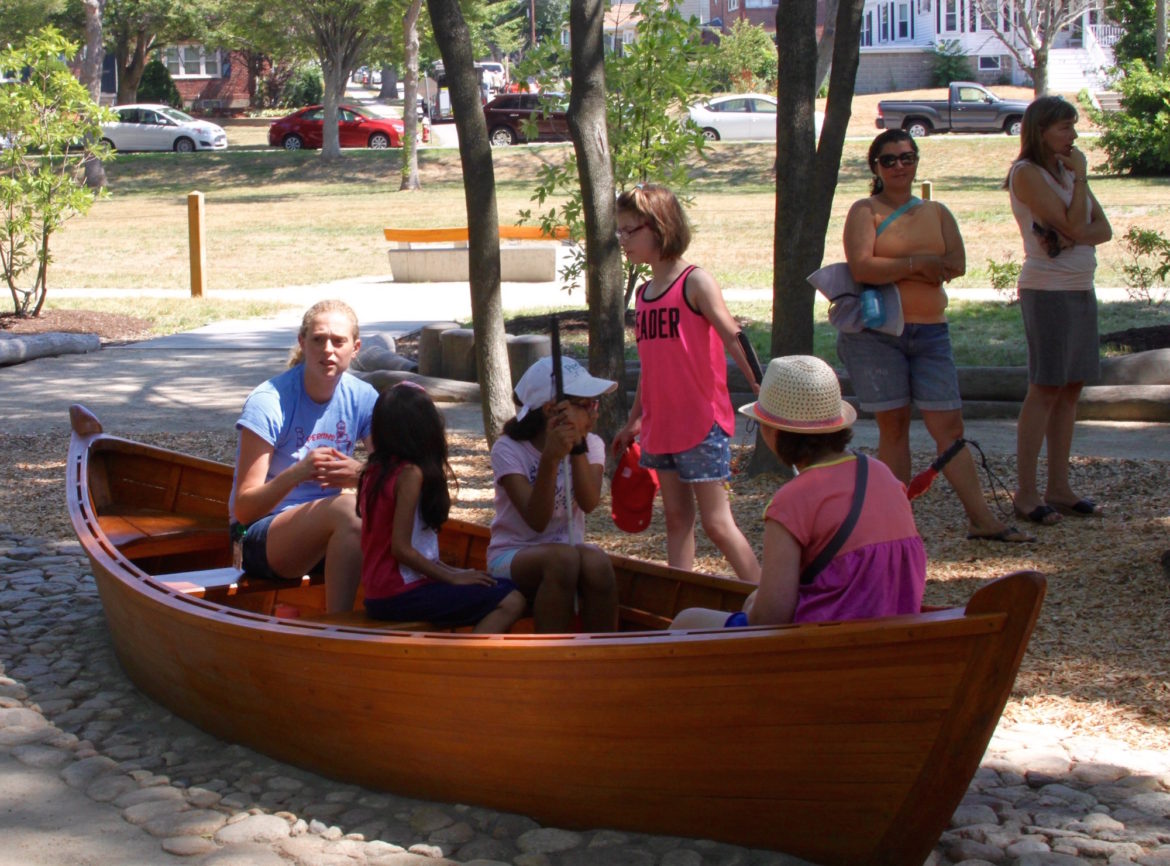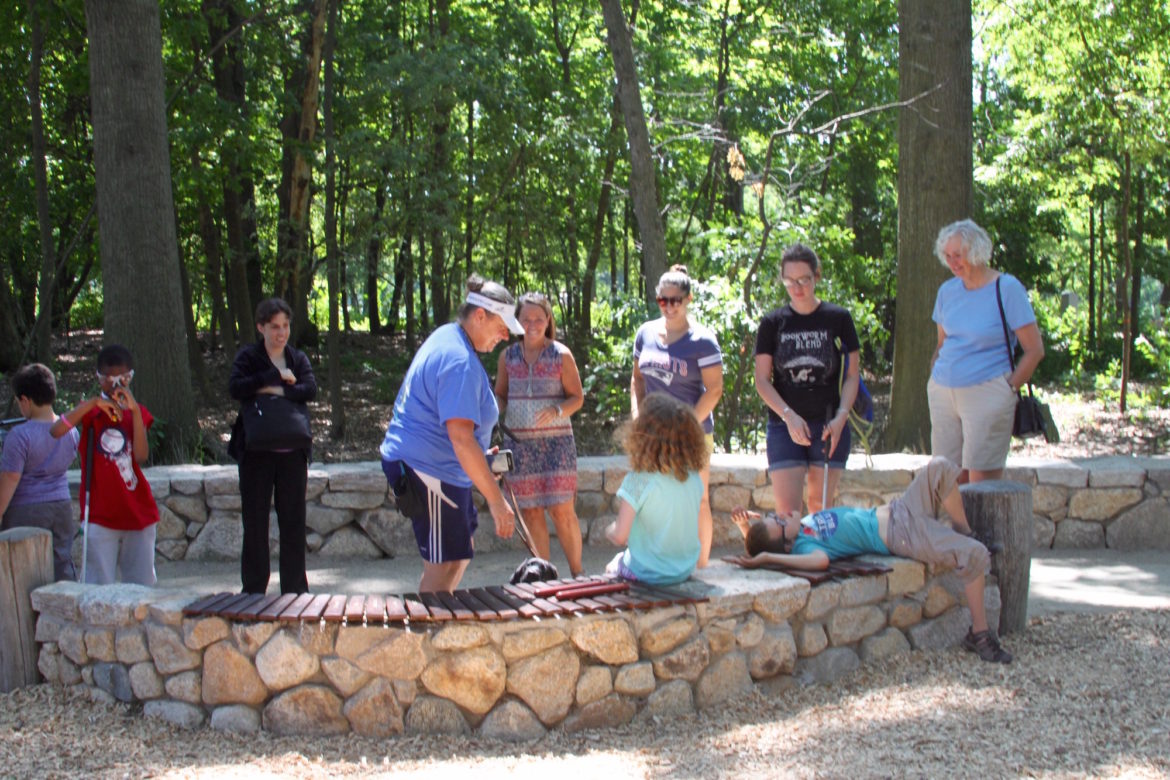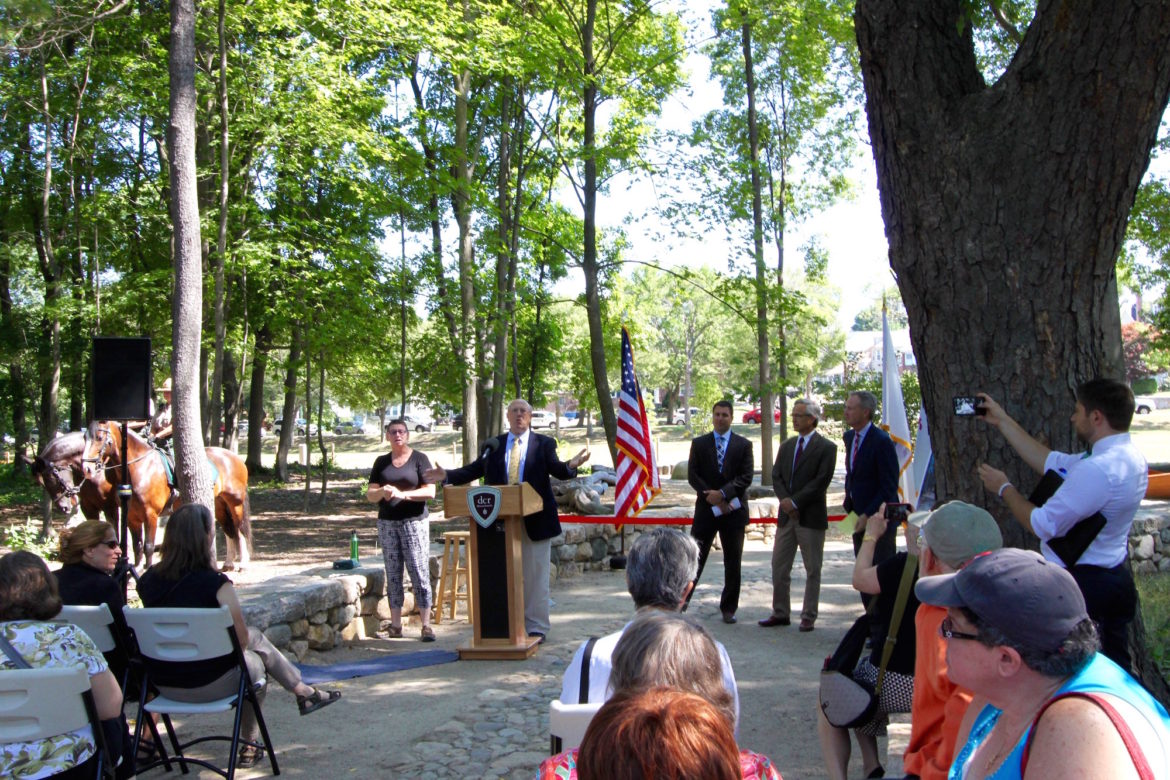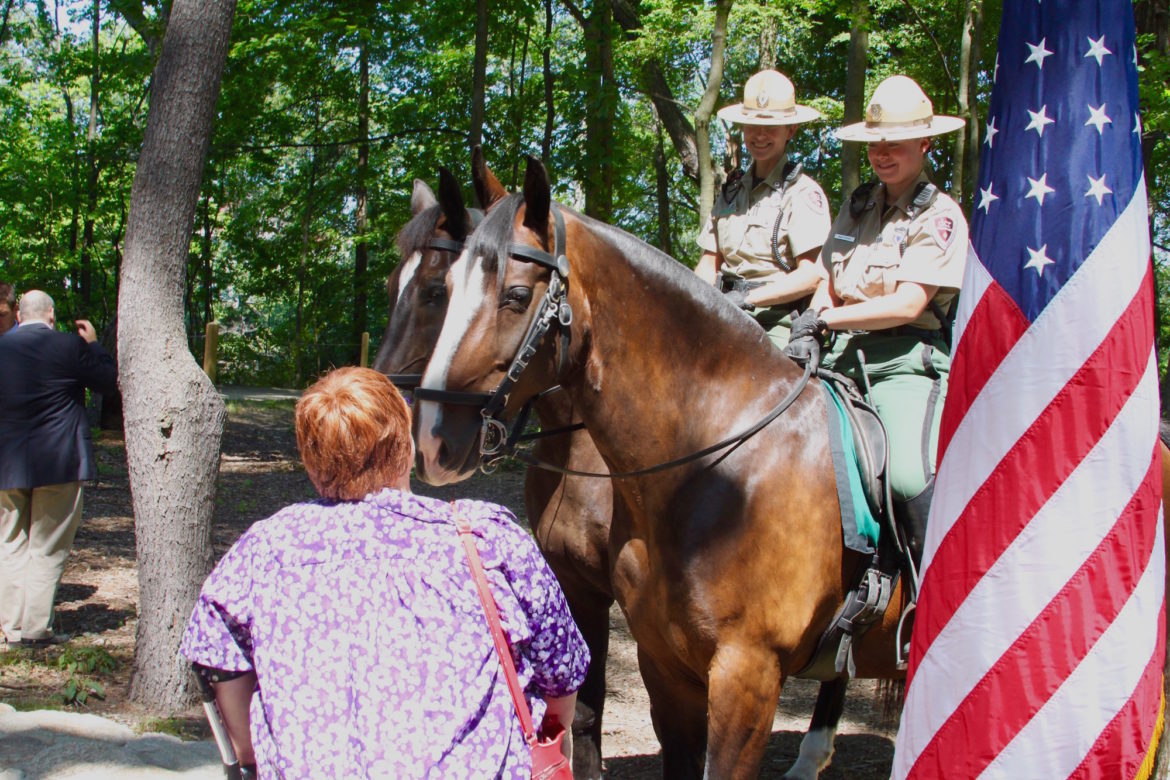
Charlie Breitrose
Children from Perkins School for the Blind sit in one of the boats along the “dry river” in the Watertown Riverfront Park and Braille Trail.
The recently refurbished section of the Charles River Path east of Watertown Square not only replaced crumbling paths with smooth and clean new ones, but added new features so that the blind and visually impaired can get more out of their visit to the area.
State officials joined local supporters at the ribbon cutting for the Watertown Riverfront Park and Braille Trail on Thursday morning. The celebration came many years after the idea of improving the area first surfaced.
“This is my first time here, and I am shocked how beautiful it turned out,” said Matt Beaton, Secretary of the Executive Office of Energy and Environmental Affairs. “It is truly a gem along the gem we have in our Charles River.”
New sand-cover paths wind along about 5,000 feet of the riverfront near the intersection of Charles River Road and Irving Street, with features such as overlooks and areas to view the river, similar to other sections of the Charles River. What’s different about the Riverfront Park is the section aimed at the visually impaired.
Sensory Garden
Exploring the park, one discovers some unique features in the wooded area. One feature that stands out immediately is the boats installed on sensory garden section of the path. In the middle of the “dry river” the path is paved with large round stones to signify the riverbed, said Mitch Ryerson, who designed that part of the park and the boats for the Department of Conservation and Recreation.
“I did not think of it as a playground, its called a sensory garden,” Ryerson said. “It’s more a place for hanging out and for blind kids to explore on their own.”
Other parts of Ryerson’s design include unique wooden benches, including one made of bars of wood that can be played like a marimba.
A section of woods has been encircled with a guide wire that helps the blind navigate the area. But it does not stop there, said Kim Charlson, director of the library at the nearby Perkins School for the Blind and a member of the Watertown Commission on Disabilities.
“This is one of the best Braille trails in the country,” Charlson said.

Charlie Breitrose
This bench can be played like a marimba. It sits in the sensory garden in the Watertown Riverfront Park.
The guide wire in many parks is mostly for navigation, said Charlson, but not in the one in Watertown.
“It’s not just a wire leading people along. It’s got experiential stations,” she said.
Blocks of wood of different shapes mark where points of interest are located. One marks a bench, another an wooden overlook and the third a text marker.
The markers have print on them for most to read, but for the blind and visually impaired there is a section in Braille just above it. Unlike many such instances, the panel with the braille is not on the same flat space as the printed part, but angled away in a way that does not require Braille readers to bend their wrists in an uncomfortable way.
The signs are filled with information about the river, trees and wildlife in the area.

Charlie Breitrose
Leo Roy, commissioner of the Department of Conservation and Recreation, speaks at the ribbon cutting at the Watertown Riverfront Park and Braille Trail.
While the DCR has a effort to make parks as accessible as possible, but this park goes beyond that. He said everyone can get an idea of what it is like for the blind, said Department of Conservation and Recreation Commissioner Leo Roy.
“Try walking around with your eyes closed,” Roy said. “Experience it. You pick up so much more here. The smells, the feel walking around. The sound of the river, the birds and the insects.”
Perkins School, which is about a 10 minute walk from the park, has already started using the park for science classes and other lessons, said Perkins President Dave Powers.
Long Time Coming
The DCR recognized the need for rehabbing the Charles River Path in Watertown around the year 2000, said Herb Nolan, who works for the Solomon Foundation, but back then was a consultant for the DCR.
“We really had to fight for every project,” Nolan said. “We looked at the entire river and said this Watertown section looks like it could be a winner. Why? Because we knew the community could come together and advocate for it.”
About four years ago, the Friends of the Watertown Riverfront formed and brought together several local groups, including the Bilezikian Family Foundation, Perkins School for the Blind, the Town of Watertown, the Lawrence and Lillian Solomon Fund, and the Watertown Community Foundation.
Many people also made sure that the project did not die, despite changes in governors and DCR commissioners and a major economic downturn. Some include Watertown State Rep. Jonathan Hecht, State Sen. Will Brownsberger, and former Town Councilors Steve Corbett and Cecilia Lenk. Former Perkins President Steven Rothstein spearheaded the effort on behalf of the school.

Charlie Breitrose
An attendee of the Watertown Riverfront Park ribbon cutting speaks with the horse mounted DCR Park Rangers.
The Solomon Fund provided much of the funds to design the park, and when it came to funding the construction, all of the groups contributed, including the Town of Watertown, which provided $100,000, said Town Council Vice President Vincent Piccirilli.
The local support encourages the state to support such projects, Commissioner Roy said.
“Public dollars fused with private money really moves a project along,” Roy said. “When you have many funders, not only does help the project happen, but you know they will be involved in the long-term care of the place.”
While the DCR will take care of the park, Perkins School for the Blind has volunteered to make sure the sensory garden is taken care of, Roy said.
Congratulations all around on making this beautiful park a reality!
Last night at the Friends of Daly Field event across the river I leaned how a particular Watertown legislator fought Simmons College and DCR on their plan for a public private venture there on the grounds of the environmental sensitivity of the site. This disagreement was eventually worked out to the tune of hundreds of thousands of dollars to assist with the rehab dicussed here on the Watertown side of the river. If this is true, we owe our Representative Hecht a debt of gratitude for his role in making this happen. Thanks, Jon!